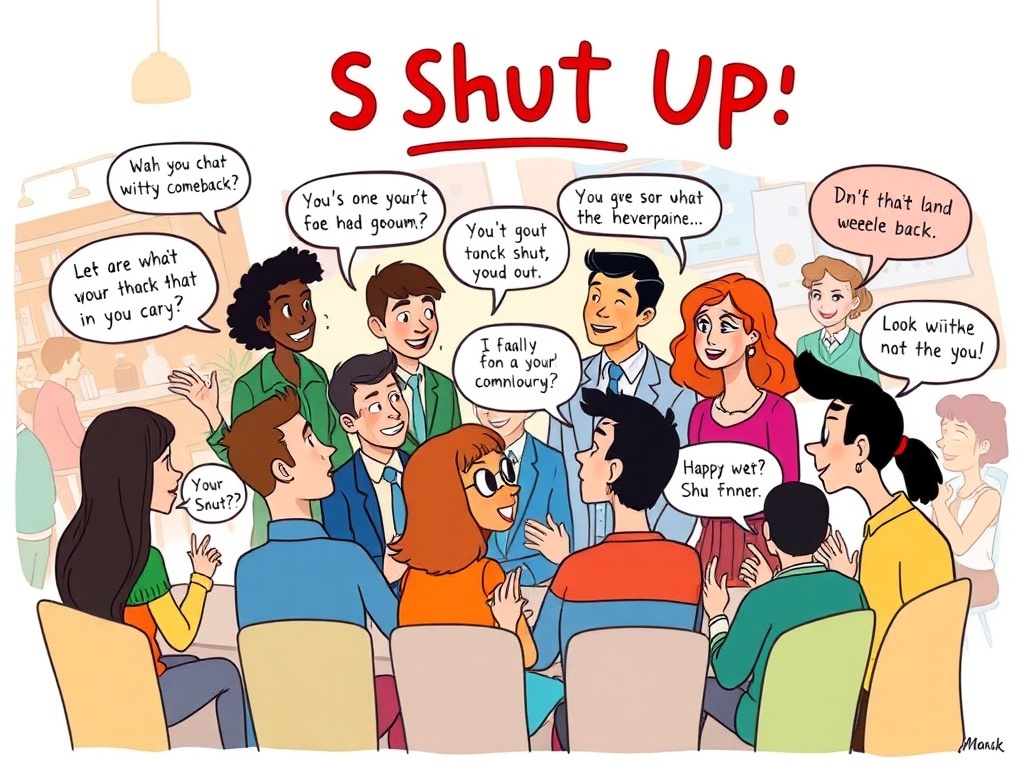Being told to “shut up” can feel like a verbal slap. It’s one of those phrases that instantly triggers our fight or flight response. The words cut deep because they dismiss not just what we’re saying, but our right to speak at all.
Most people freeze when confronted with this verbal disrespect. They either lash out in anger or retreat in hurt silence. Neither response serves us well in the long run.
This comprehensive guide will equip you with powerful strategies for handling these moments with grace and assertiveness. You’ll learn how to protect your dignity while maintaining healthy boundaries in any situation.
Understanding the Psychology Behind “Shut Up”
Why People Use This Phrase
When someone tells you to “shut up,” they’re usually operating from a place of emotional overwhelm. The phrase serves multiple psychological functions:
Power dynamics play a major role. The person may feel threatened by what you’re saying. They use aggressive language to regain control of the conversation.
Emotional regulation failures often trigger this response. When people can’t handle their own feelings, they try to silence the source of their discomfort.
Chronic disrespect patterns may be at play. Some individuals have learned to use dismissive language as their default communication style.
Insecurity frequently drives this behavior. People who feel inadequate often resort to shutting others down rather than engaging thoughtfully.
The Emotional Impact on Recipients
Being told to “shut up” activates our nervous system in predictable ways:
- Immediate shock and disbelief
- Anger at being dismissed
- Hurt feelings from the rejection
- Confusion about how to respond
- Self-doubt about our right to speak
These emotions are completely normal. The key is learning to navigate them skillfully rather than letting them control our responses.
Recognizing the Context Matters
Not every “shut up” carries the same weight or intent. Contextual tone and intent and meaning vary dramatically:
Playful banter between close friends often includes teasing language that would be inappropriate elsewhere.
High-stress situations can cause even kind people to speak harshly without meaning real harm.
Chronic patterns of dismissive behavior signal deeper relationship problems that need addressing.
Power imbalances in workplace or family settings create different dynamics than peer-to-peer interactions.
Immediate Response Strategies
The Power of the Pause
Your first instinct might be to react immediately. Resist this urge. Thoughtful responses almost always serve you better than knee-jerk reactions.
Take a deep breath. Count to three. This brief pause accomplishes several things:
- Prevents emotional regulation failures
- Gives you time to assess the situation
- Signals that you won’t be rushed into a reaction
- Maintains your dignity and composure
Reading Non-Verbal Cues
Non-verbal cues often tell you more than words alone. Pay attention to:
Body language – Are they tense and aggressive, or relaxed and joking?
Facial expressions – Do you see anger, frustration, or playfulness?
Tone of voice – Is it harsh and cutting, or light and teasing?
Eye contact – Are they trying to intimidate or avoiding your gaze?
These signals help you calibrate your response appropriately.
Quick Assessment Questions
Before responding, quickly ask yourself:
- What’s the relationship dynamic here?
- Is this person usually respectful or dismissive?
- Are they stressed about something else?
- What outcome do I want from this interaction?
- Is this worth escalating or should I de-escalate?
Assertive Response Techniques
Setting Clear Boundaries
Boundaries are essential for healthy communication. When someone tells you to “shut up,” they’re crossing a line. Address this directly but calmly:
“I don’t appreciate being spoken to that way. Let’s discuss this respectfully.”
“That language isn’t okay with me. Can we try again?”
“I’m willing to listen to your concerns, but not when you’re being dismissive.”
These responses accomplish multiple goals:
- They clearly state your boundaries
- They don’t escalate the conflict
- They keep the door open for productive dialogue
- They maintain your self-respect
The Broken Record Technique
Sometimes people don’t hear you the first time. The broken record technique involves calmly repeating your boundary until it’s acknowledged:
First attempt: “I’d like to finish my thought, please.”
Second attempt: “As I was saying, I’d like to finish my thought.”
Third attempt: “I’m going to continue with what I was saying.”
This technique works because it:
- Shows you won’t be intimidated
- Avoids getting drawn into arguments
- Maintains focus on the real issue
- Demonstrates consistent assertiveness
Using “I” Statements
“I” statements are powerful tools for conflict resolution. They express your feelings without attacking the other person:
Instead of: “You’re being rude!”
Try: “I feel dismissed when you tell me to shut up.”
Instead of: “You never listen!”
Try: “I need to feel heard in our conversations.”
This approach:
- Reduces defensiveness in others
- Keeps focus on your experience
- Opens space for empathy
- Promotes healthier interpersonal dynamics
Humorous and Light-Hearted Approaches
When Humor Works Best
Humor in communication can be incredibly effective, but timing is crucial. Use humor when:
- The relationship is generally positive
- The person seems stressed rather than malicious
- You want to de-escalate tension
- The setting is informal and relaxed
Effective Humorous Responses
“Wow, that’s the nicest thing anyone’s said to me all day!”
“My mouth doesn’t come with an off switch, but I can try to find the volume control.”
“I’ll shut up right after I finish this incredibly important point about…”
“Sorry, I don’t speak ‘shut up.’ Could you translate that to ‘please be quiet’?”
These responses work because they:
- Defuse tension through laughter
- Show you won’t be intimidated
- Demonstrate social intelligence
- Keep relationships intact
Risks of Using Humor
Humor can backfire if:
- The person is genuinely angry
- There are serious underlying issues
- The power dynamic is too unequal
- Your humor comes across as dismissive
Read the room carefully before choosing this approach.
Professional and Workplace Responses
Navigating Power Dynamics
Workplace “shut up” situations require extra care due to power dynamics. Your response depends on who’s speaking:
If it’s a peer: Address it directly but professionally
If it’s your boss: Document the incident and consider HR involvement
If it’s a subordinate: Set clear professional boundaries immediately
Professional Response Templates
“I’d prefer if we could discuss this professionally.”
“Let’s take a step back and approach this more constructively.”
“I think we both want to solve this problem. Can we focus on that?”
“I’m committed to finding a solution, but I need respectful dialogue to do that.”
These responses maintain professionalism while addressing the inappropriate language.
Documentation and Follow-Up
In workplace settings, consider:
- Writing down what happened immediately
- Following up with an email summarizing the conversation
- Involving HR if it’s a pattern of chronic disrespect
- Seeking support from trusted colleagues or mentors
Creating Boundaries with Colleagues
Establish clear communication expectations:
- “I work best when we can discuss issues calmly.”
- “I’m always open to feedback when it’s delivered respectfully.”
- “Let’s agree to keep our conversations professional.”
Dealing with Family Members
Understanding Family Dynamics
Family “shut up” situations often carry decades of history. Interpersonal dynamics run deep, and patterns can be hard to break.
Common family triggers include:
- Old resentments and unresolved conflicts
- Stress from major life changes
- Different communication styles across generations
- Chronic disrespect patterns established in childhood
Age-Appropriate Responses
With parents: Balance respect with assertiveness
“I understand you’re frustrated, but I need to express my thoughts too.”
With siblings: Address patterns directly
“We’re adults now. Let’s talk to each other like it.”
With children: Model healthy communication
“In our family, we don’t tell each other to shut up. Let’s try again.”
Setting Family Boundaries
Family boundaries require consistent reinforcement:
- Be clear about what language you’ll accept
- Follow through with consequences
- Don’t enable passive-aggressive behavior
- Seek family counseling if patterns persist
Breaking Generational Patterns
If “shut up” was common in your childhood, breaking the cycle requires:
- Conscious awareness of your own triggers
- Commitment to different communication patterns
- Self-care practices to manage your emotional regulation
- Professional support when needed
Managing Your Emotional Response
Recognizing Your Triggers
Understanding your emotional patterns helps you respond rather than react. Common triggers include:
- Feeling unheard or dismissed
- Memories of past disrespect
- Fear of confrontation
- Anger at being controlled
Emotional Regulation Techniques
Deep breathing: Slow, intentional breaths calm your nervous system
Grounding exercises: Feel your feet on the floor, notice your surroundings
Positive self-talk: Remind yourself that their words don’t define you
Perspective-taking: Consider what might be driving their behavior
The STOP Technique
When emotions run high, use this acronym:
S – Stop what you’re doing T – Take a breath O – Observe what’s happening P – Proceed with intention
This simple framework prevents emotional regulation failures and keeps you in control of your responses.
Long-Term Emotional Health
Protecting your emotional well-being requires:
- Regular self-care practices
- Healthy relationships that model respect
- Professional support when dealing with emotional abuse
- Personal growth activities that build confidence
When to Walk Away
Recognizing Red Flags
Some situations require removing yourself rather than engaging further. Red flags include:
- Chronic disrespect that doesn’t improve
- Escalating aggression or threats
- Emotional abuse patterns
- Situations where your safety feels at risk
The Strategic Retreat
Walking away isn’t giving up—it’s protecting yourself. Effective exit strategies include:
“I’m not willing to continue this conversation right now.”
“Let’s discuss this when we can both be respectful.”
“I need some space to think about this.”
“This isn’t productive. I’m going to step away.”
Protecting Your Energy
Your mental and emotional energy are precious resources. Don’t waste them on people who consistently show verbal disrespect.
Boundaries aren’t walls—they’re gates. You get to decide who has access to your time and attention.
When Professional Help Is Needed
Consider seeking support if:
- The behavior is affecting your mental health
- You’re experiencing symptoms of anxiety or depression
- The situation involves emotional abuse or manipulation
- You feel trapped or helpless in the relationship
Building Long-Term Communication Skills
Developing Assertiveness
Assertiveness is a learnable skill that improves with practice. Key components include:
Clear communication: Say what you mean directly but kindly
Consistent boundaries: Don’t let people cross lines repeatedly
Self-respect: Value your own thoughts and feelings
Empathy: Understand others without sacrificing yourself
Practicing Active Listening
Good communication goes both ways. Develop your listening skills:
- Give full attention when others speak
- Ask clarifying questions
- Reflect back what you hear
- Validate emotions even when you disagree with actions
Conflict Resolution Skills
Healthy conflict resolution transforms disagreements into opportunities for growth:
Focus on specific behaviors rather than character attacks
Use collaborative language like “we” and “us”
Seek win-win solutions that address everyone’s core needs
Take breaks when emotions get too heated
Building Emotional Intelligence
Emotional regulation and empathy are foundational to all healthy relationships. Develop these skills through:
- Mindfulness practices
- Regular self-reflection
- Reading about interpersonal dynamics
- Seeking feedback from trusted friends
Creating Respectful Relationships
Modeling Good Communication
The best way to get respect is to give it consistently. Model the communication you want to receive:
- Listen without interrupting
- Express disagreement without personal attacks
- Ask questions instead of making assumptions
- Apologize when you make mistakes
Choosing Your Circle Wisely
Surround yourself with people who value respectful communication. Life’s too short for relationships built on chronic disrespect.
Quality relationships share certain characteristics:
- Mutual respect and consideration
- Open, honest communication
- Willingness to work through conflicts
- Support for each other’s growth
Setting Relationship Standards
Be clear about your non-negotiables:
- How you expect to be spoken to
- What behaviors you won’t tolerate
- How you handle disagreements
- What respect looks like in action
Continuous Growth and Learning
Personal growth never stops. Keep developing your communication skills through:
- Reading books on relationships and communication
- Taking courses or workshops
- Working with a therapist or coach
- Practicing new skills in safe relationships
Recovery and Self-Care After Difficult Interactions
Processing the Experience
After being told to “shut up,” give yourself time to process:
- Acknowledge your emotions without judgment
- Talk to a trusted friend or therapist
- Journal about what happened and how you felt
- Identify what you learned from the experience
Self-Compassion Practices
Be kind to yourself in the aftermath:
- Remember that someone else’s disrespect doesn’t reflect your worth
- Practice positive self-talk
- Engage in activities that make you feel good
- Celebrate moments when you handled things well
Rebuilding Confidence
If the interaction shook your confidence, rebuild it gradually:
- Practice assertiveness in low-stakes situations
- Remind yourself of your strengths and accomplishments
- Seek support from people who value and respect you
- Focus on personal growth rather than perfection
Learning from Each Experience
Every difficult interaction offers lessons:
- What triggered your emotional response?
- How could you handle it differently next time?
- What boundaries need to be clearer?
- How can you better protect your well-being?
Conclusion
Being told to “shut up” doesn’t have to derail your day or damage your self-esteem. With the right tools and mindset, you can handle these moments with grace and assertiveness.
The key is preparation. When you know how to respond, you feel more confident in difficult conversations. You protect your boundaries while maintaining your relationships and self-respect.
Remember that communication is a skill that improves with practice. Every interaction is an opportunity to strengthen your emotional regulation, deepen your empathy, and refine your assertiveness.
The strategies in this guide work best when you adapt them to your unique situation. Consider the relationship, the context, and your personal growth goals when choosing your response.
Most importantly, remember that you deserve to be treated with respect. Don’t settle for chronic disrespect or verbal disrespect in any relationship. Your voice matters, and you have the right to be heard.
By developing these skills, you’re not just learning to handle difficult moments—you’re building a foundation for healthier, more fulfilling relationships in all areas of your life. The investment in better communication pays dividends in personal growth, stronger connections, and greater self-care.
Start practicing these techniques today. Your future self will thank you for developing the skills to navigate life’s challenging conversations with confidence and grace.

Catherine Frank, founder of BiblicalHorizon.com, shares daily prayers and Bible verses to nurture spiritual growth. With a lifelong passion for scripture and prayer traditions, she creates accessible spiritual content that resonates with both seasoned believers and newcomers seeking divine connection.


